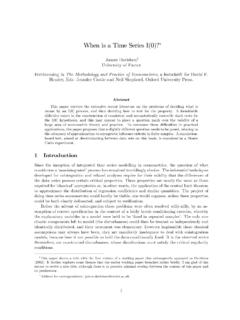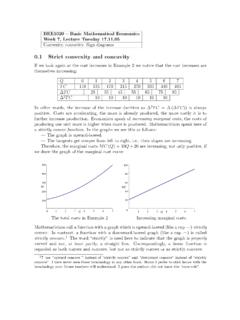Transcription of Weaving It Together - Exeter
1 Instructor s ManualBooks 3 and 4 Weaving It TogetherConnecting Reading and WritingThird EditionTeaching Hints and Answer KeyWriting HandbookMilada Broukal John Chapman Patricia BrennerAustralia Brazil Japan Korea Mexico Singapore Spain United Kingdom United 114/12/09 2:07 PMCopyright 2010 Heinle, Cengage LearningALL RIGHTS RESERVED. No part of this work covered by the copyright herein may be reproduced, transmitted, stored, or used in any form or by any means graphic, electronic, or mechanical, including but not limited to photocopying, recording, scanning, digitizing, taping, Web distribution, information networks, or information storage and retrieval systems, except as permitted under Section 107 or 108 of the 1976 United States Copyright Act, without the prior written permission of the : 978-1-111-00238-1 ISBN-10.
2 1-111-00238-XHeinle20 Channel Center StreetBoston, MA 02210 USAC engage Learning is a leading provider of customized learning solutions with offi ce locations around the globe, including Singapore, the United Kingdom, Australia, Mexico, Brazil, and Japan. Locate your local offi ce at: Learning products are represented in Canada by Nelson Education, Heinle online at our corporate website at It Together : Connecting Reading and Writing, Instructor s Manual, Books 3 and 4, Third EditionMilada Broukal, John Chapman, and Patricia BrennerPublisher: Sherrise RoehrAcquisitions Editor: Thomas Jeff eriesEditorial Manager: Berta de LlanoSenior Development Editor: Margarita Matte Director of Global Marketing: Ian Martin Director of Marketing.
3 Jim McDonoughSenior Marketing Manager: Katie Kelly Marketing Manager: Caitlin DriscollMarketing Assistant: Anders Bylund Director of Content and Media Production: Michael BurggrenContent Product Manager: Mark RzeszutekPrint Buyer: Susan Spencer Cover Design: Page2 LLC ; Gina Petti, Rotunda DesignCompositor: Glyph InternationalFor product information and technology assistance, contact us at Cengage Learning Customer & Sales Support, 1-800-354-9706 For permission to use material from this text or product, submit all requests online at Further permissions questions can be emailed in the United States of America1 2 3 4 5 6 7 11 214/12/09 2.
4 07 PMContents 3 To the Teacher 4 Sample Lesson Plan, Book 3 6 Sample Lesson Plan, Book 4 9 Sample grading rubric for Written Work 12 Sample Correction Symbols 13 Sample Student Essay with Correction Symbols 14 Teaching Hints and Answer Key, Book 3 16 Writing Handbook, Book 3 64 Teaching Hints and Answer Key, Book 4 74 Writing Handbook, Book 4 119 Glossary of Grammar/Language Terms 125 Contents 314/12/09 2:07 PM4 To the TeacherTo the TeacherOrganization of the Student BookWeaving It Together , Book 3, has eight units.
5 Each unit is divided into two chapters related to the unit theme. Weaving It Together , Book 4, has nine chapters. Each chapter has two readings related to a single chapter theme. The themes have been carefully selected to appeal to a wide range of interests and to promote discussion and comparison of different sequence of activities in each chapter follows this pattern: What Do You Think? activity Pre-reading and predicting activities Reading Vocabulary activities Comprehension activities Discussion and critical thinking questions Writing skills Writing practice activitiesEach step in the sequence is important to the fi nal goal of enabling students to produce excellent written English.
6 All skills of reading, writing, generating ideas, and developing vocabulary are integrated throughout each chapter with the aim of achieving this of Written WorkThe criteria you choose for grading your students written work will vary according to the aims in your course description. In general, your students can be expected to hand in at least one preliminary draft of their work before handing in their fi nal draft. The process of re-writing and editing written work is consistently emphasized in this series. The editing tips at the end of each section will help students become effective editors of their own and each other s work.
7 It is also important to value original and thoughtful writing as well as the amount of effort invested in the are some suggestions for correcting students written work: Use written correction symbols so that students have to fi nd their own mistakes (see page 13 for examples). Make clear your criteria for grading written work. You may want to use the same criteria each time, or you may prefer to focus on specifi c points. You might focus on paragraph formatting for the fi rst assignment, for example, and then gradually add other criteria such as grammar, vocabulary, and content.
8 See page 12 for possible writing rubrics, which may be adapted for your class. Have students work in pairs to check their essays before handing them in. Peer editing is a great way to help students learn to become more independent. Encourage students to use the editing checklist at the end of each chapter in the student book when correcting each other s work. Remember that a page covered in corrections is going to be very discouraging for your students. If one mistake recurs frequently in an essay, correct it just once and ask the student to fi nd other examples of the mistake by himself or herself.
9 Remember to use a balance of both praise and criticism in your comments! 414/12/09 2:07 PMTo the Teacher 5 JournalsJournals provide an effective way of increasing the value of class time, as they encourage learning outside of class. Students can experiment with new language they have recently learned or read, prepare their thoughts about a topic before discussing it in class, or respond in a personal way to the topics that are discussed in class. Journals are especially effective with shy or quiet students, who may not feel comfortable speaking out in class.
10 They are also an excellent way for you to get direct feedback from students as to how well they have understood a lesson and what their feelings are about the topics under discussion. Journals allow teachers to communicate directly with individual students on a regular is no doubt that the use of journals creates extra work for the teacher! Be realistic about how much time you can spend on reading and responding to your students journal writing. However, the more enthusiastic you are about journals, the better your students will respond, and you may fi nd yourself learning a great deal that will ultimately help you to understand your students better and aid you in your classroom teaching.







